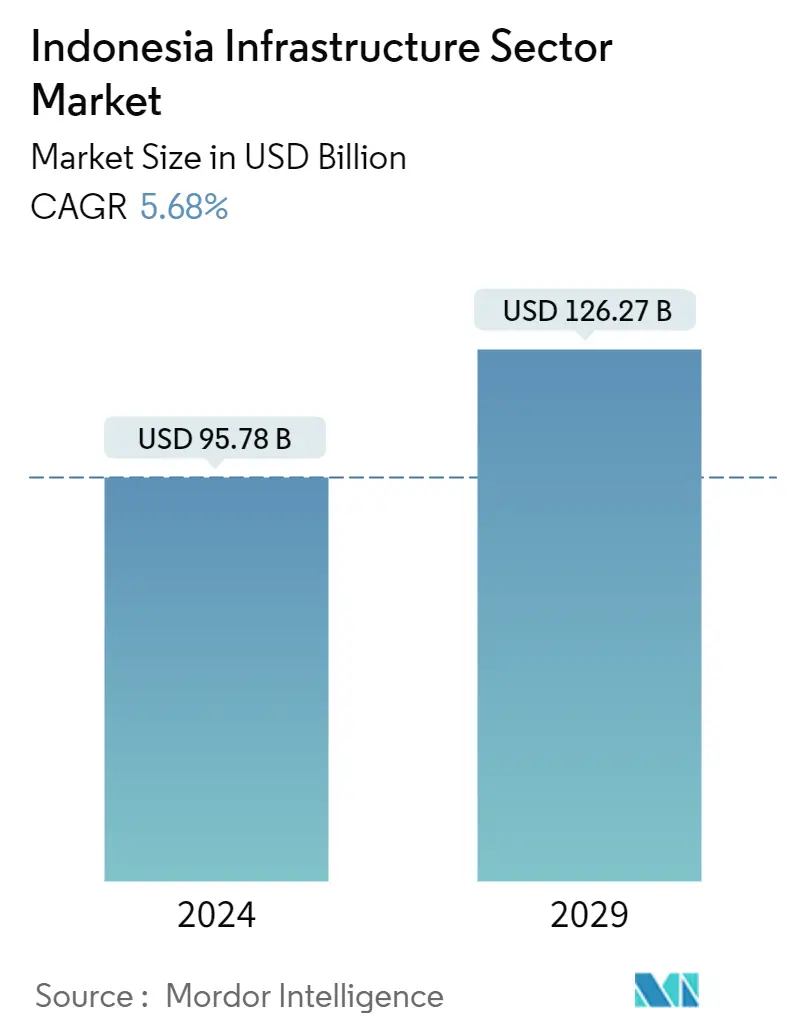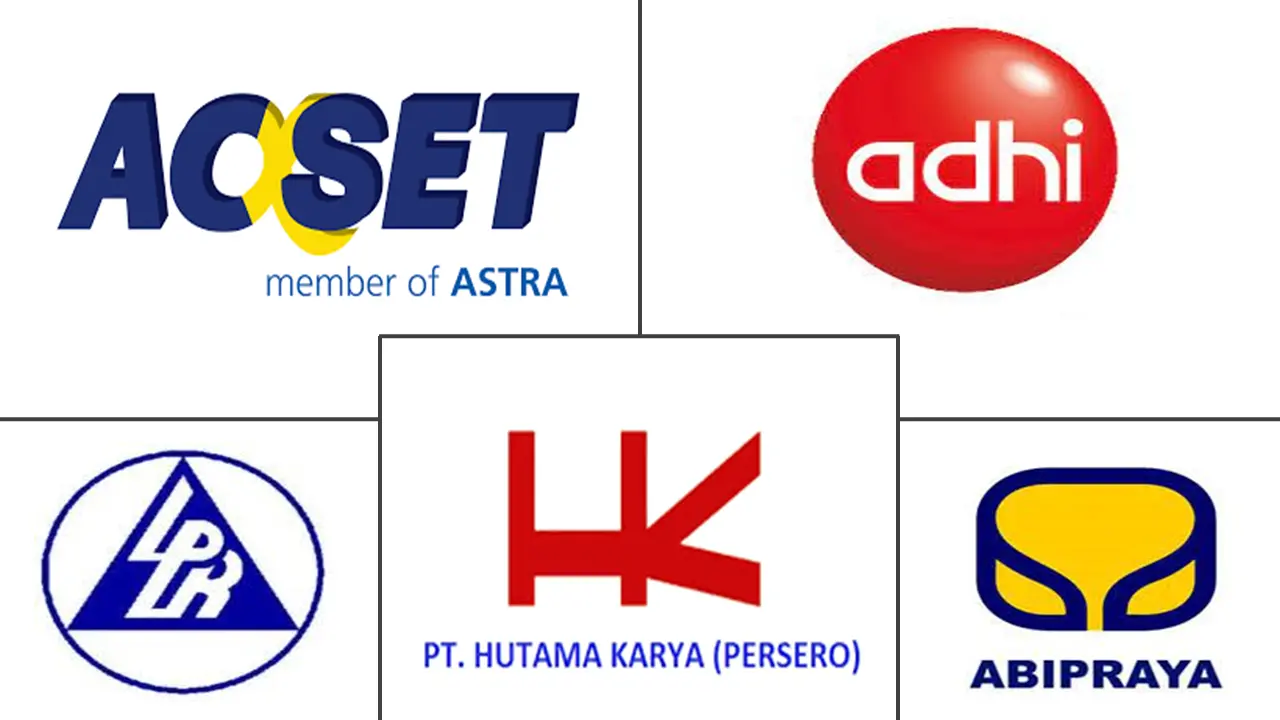Market Size of Indonesia Infrastructure Sector Industry

| Study Period | 2020 - 2029 |
| Base Year For Estimation | 2023 |
| Market Size (2024) | USD 95.78 Billion |
| Market Size (2029) | USD 126.27 Billion |
| CAGR (2024 - 2029) | 5.68 % |
| Market Concentration | Medium |
Major Players
*Disclaimer: Major Players sorted in no particular order |
Indonesia Infrastructure Market Analysis
The Indonesia Infrastructure Sector Market size is estimated at USD 95.78 billion in 2024, and is expected to reach USD 126.27 billion by 2029, growing at a CAGR of 5.68% during the forecast period (2024-2029).
- Indonesia's government increased its infrastructure investments by USD 429.7 billion in 2020-2024, up 20% from USD 359.2 billion in 2015-2019. After a decline brought on by the COVID-19 crisis, aggregate production in Indonesia significantly increased in 2021. The Indonesian government has initiated a program to upgrade basic infrastructure, including roads, airports, and seaports, which will likely stimulate demand for building materials. Infrastructure development was given IDR 414 trillion (USD 28.5 billion) in the country's 2021 state budget, a 47% increase from the 2020 budget.
- According to the spokesperson of Volvo Construction Equipment, several ongoing significant projects are boosting the demand for aggregates and quarrying equipment in the nation.
- Infrastructure financing through the country's Government and Private Cooperation Scheme reached 83 projects with a total investment of USD 40 billion. About 30 projects totaling USD 50 billion were generated for the non-government budget expenditure financing scheme.
- In 2021, the PUPR Ministry continued its priority and strategic initiatives to improve national priority achievements, including infrastructure, balanced regional growth, and the sustainability of food, energy, and living climate in the infrastructure sector. These national priorities are implemented through water resource management by improving quantity, quality, and water accessibility, covered by ongoing dam constructions (49 dams).
- The large population and robust domestic demand in Indonesia are anticipated to result in favorable economic growth in the Indonesian infrastructure sector. With 250 million people, more than half of whom reside in cities, Indonesia has a sizable domestic market. Additionally, an expanding and wealthy middle class promotes GDP growth, with about 60% of GDP coming from private consumption.
Indonesia Infrastructure Industry Segmentation
Infrastructure is the backbone of domestic and international commerce and industrial and agricultural production. It is the fundamental organizational and physical framework necessary to operate a firm successfully. Basic infrastructure in an organization or a nation comprises communication and transportation, sewage, water, a health and education system, safe drinking water, and a monetary system. A complete background analysis of the United Kingdom EV Charging Infrastructure Market, including the assessment of the economy and contribution of sectors in the economy, a market overview, market size estimation for key segments, emerging trends in the market segments, market dynamics, and geographical trends, and COVID-19 impact, is covered in the report.
The Infrastructure Sector in Indonesia is Segmented by the Infrastructure Segment (Social Infrastructure, Transportation Infrastructure, Extraction Infrastructure, Utilities Infrastructure and Manufacturing Infrastructure). The Market Size and Forecast Values (USD) for all the Above Segments.
| By Infrastructure Segment | |
| Social Infrastructure | |
| Transportation Infrastructure | |
| Extraction Infrastructure | |
| Manufacturing Infrastructure | |
| Utilities Infrastructure |
Indonesia Infrastructure Sector Market Size Summary
The Indonesian infrastructure sector is poised for significant growth, driven by substantial government investments and a focus on enhancing connectivity across the archipelago. The government's commitment to upgrading essential infrastructure, such as roads, airports, and seaports, is expected to stimulate demand for construction materials and equipment. This initiative is part of a broader strategy to boost economic growth, supported by the country's large and growing population, which provides a robust domestic market. The construction industry plays a crucial role in Indonesia's economy, being the fourth-largest contributor to GDP, with a significant portion of investment directed towards Java Island, particularly Jakarta. However, there is a strategic push to decentralize development activities to other regions, aiming to reduce disparities and promote balanced regional growth.
The market landscape is characterized by a fragmented structure with numerous regional and local players, including major companies like PT. Acset Indonusa TBK and PT. Adhi Karya (Persero) TBK. The government's use of public-private partnerships (PPPs) is instrumental in attracting both domestic and foreign investments, particularly in the transport and energy sectors. Recent collaborations, such as the memorandum of understanding with the Japan Bank for International Cooperation, highlight efforts to integrate sustainable practices, like hydrogen and ammonia fuel projects, into infrastructure development. Additionally, ongoing projects, such as the expansion of the Tanjung Priok harbor, underscore the government's commitment to enhancing infrastructure quality and capacity. These developments, coupled with strategic initiatives in various regions, are expected to drive the growth of the infrastructure market in Indonesia over the forecast period.
Indonesia Infrastructure Sector Market Size - Table of Contents
-
1. MARKET DYNAMICS
-
1.1 Market Overview
-
1.1.1 Market Drivers
-
1.1.1.1 Growing urbanisation in the countries
-
1.1.1.2 Increasing support of private sector to meet infrastructural growth in various sectors such as water, energy, transportation, and communications
-
-
1.1.2 Market Restraints
-
1.1.2.1 Lack of quality and quantity of infrastructure
-
-
1.1.3 Market Opportunities
-
1.1.3.1 Technological advancements are transforming the fundamental nature of infrastructure investment
-
-
-
1.2 Value Chain/Supply Chain Analysis
-
1.3 Industry Attractiveness - Porter's Five Forces Analysis
-
1.3.1 Bargaining Power of Suppliers
-
1.3.2 Bargaining Power of Buyers/Consumers
-
1.3.3 Threat of New Entrants
-
1.3.4 Threat of Substitute Products
-
1.3.5 Intensity of Competitive Rivalry
-
-
1.4 Market Insights
-
1.4.1 Current Economic and Infrastructure Market Scenario
-
1.4.2 Technological Innovations in the Industry
-
1.4.3 Impact of Government Regulations and Initiatives on the Industry
-
1.4.4 Impact of COVID -19 on the Market
-
-
-
2. MARKET SEGMENTATION
-
2.1 By Infrastructure Segment
-
2.1.1 Social Infrastructure
-
2.1.2 Transportation Infrastructure
-
2.1.3 Extraction Infrastructure
-
2.1.4 Manufacturing Infrastructure
-
2.1.5 Utilities Infrastructure
-
-
Indonesia Infrastructure Sector Market Size FAQs
How big is the Indonesia Infrastructure Sector Market?
The Indonesia Infrastructure Sector Market size is expected to reach USD 95.78 billion in 2024 and grow at a CAGR of 5.68% to reach USD 126.27 billion by 2029.
What is the current Indonesia Infrastructure Sector Market size?
In 2024, the Indonesia Infrastructure Sector Market size is expected to reach USD 95.78 billion.

